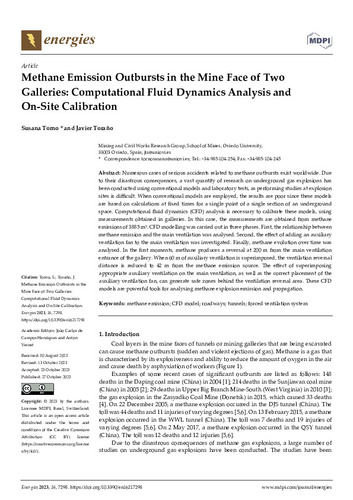Methane Emission Outbursts in the Mine Face of Two Galleries: Computational Fluid Dynamics Analysis and On-Site Calibration.
Autor(es) y otros:
Palabra(s) clave:
Methane emission
CFD model
Roadways
Tunnels
Forced ventilation system
Fecha de publicación:
Editorial:
MDPI
Versión del editor:
Citación:
Resumen:
Numerous cases of serious accidents related to methane outbursts exist worldwide. Due to their disastrous consequences, a vast quantity of research on underground gas explosions has been conducted using conventional models and laboratory tests, as performing studies at explosion sites is difficult. When conventional models are employed, the results are poor since these models are based on calculations at fixed times for a single point of a single section of an underground space. Computational fluid dynamics (CFD) analysis is necessary to calibrate these models, using measurements obtained in galleries. In this case, the measurements are obtained from methane emissions of 3885 m3. CFD modelling was carried out in three phases. First, the relationship between methane emission and the main ventilation was analysed. Second, the effect of adding an auxiliary ventilation fan to the main ventilation was investigated. Finally, methane evolution over time was analysed. In the first moments, methane produces a reversal at 200 m from the main ventilation entrance of the gallery. When 60 m of auxiliary ventilation is superimposed, the ventilation reversal distance is reduced to 42 m from the methane emission source. The effect of superimposing appropriate auxiliary ventilation on the main ventilation, as well as the correct placement of the auxiliary ventilation fan, can generate safe zones behind the ventilation reversal area. These CFD models are powerful tools for analysing methane explosion emission and propagation.
Numerous cases of serious accidents related to methane outbursts exist worldwide. Due to their disastrous consequences, a vast quantity of research on underground gas explosions has been conducted using conventional models and laboratory tests, as performing studies at explosion sites is difficult. When conventional models are employed, the results are poor since these models are based on calculations at fixed times for a single point of a single section of an underground space. Computational fluid dynamics (CFD) analysis is necessary to calibrate these models, using measurements obtained in galleries. In this case, the measurements are obtained from methane emissions of 3885 m3. CFD modelling was carried out in three phases. First, the relationship between methane emission and the main ventilation was analysed. Second, the effect of adding an auxiliary ventilation fan to the main ventilation was investigated. Finally, methane evolution over time was analysed. In the first moments, methane produces a reversal at 200 m from the main ventilation entrance of the gallery. When 60 m of auxiliary ventilation is superimposed, the ventilation reversal distance is reduced to 42 m from the methane emission source. The effect of superimposing appropriate auxiliary ventilation on the main ventilation, as well as the correct placement of the auxiliary ventilation fan, can generate safe zones behind the ventilation reversal area. These CFD models are powerful tools for analysing methane explosion emission and propagation.
ISSN:
DOI:
Patrocinado por:
This research was funded by Hullera Vasco Leonesa S.A. Company, (Vice-Rectorate for Research: 0039/001)
Colecciones
- Artículos [37544]
- Explotación y Prospección de Minas [323]
Ficheros en el ítem





